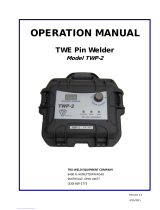
B-4
OPERATION
B-4
WELDING CONTROLS (Items 10 through 19)
1
0. OUTPUT CONTROL: The OUTPUT dial is used to pre-
set the output voltage or current as displayed on the dig-
ital meters for the four welding modes. When in the CC-
STICK, DOWNHILL PIPE or CV-WIRE modes and when
a
remote control is connected to the 6-Pin or 14-Pin
Connector, the auto-sensing circuit automatically switch-
e
s the OUTPUT CONTROL from control at the welder to
the remote control. In the CV-WIRE mode, when the
wire feeder control cable is connected to the 14-Pin
Connector, the auto-sensing circuit automatically makes
OUTPUT CONTROL inactive and the wire feeder volt-
age control active.
When in the TOUCH START TIG mode and when a
Amptrol is connected to the 6-Pin Connector, the OUT-
PUT dial is used to set the maximum current range of the
CURRENT CONTROL of the Amptrol.
11. DIGITAL OUTPUT METERS:
The digital meters allow the output voltage (CV-WIRE
mode) or current (CC-STICK, DOWNHILL PIPE and TIG
modes) to be set prior to welding using the OUTPUT con-
trol knob. During welding, the meters display the actual
output voltage (VOLTS) and current (AMPS). A memory
feature holds the display of both meters on the seven
seconds after welding is stopped. This allows the opera-
tor to read the actual current and voltage just prior to
when welding was ceased. While the display is being held
the left-most decimal point in each display will be flashing.
The accuracy of the meters is ± 3%.
12. WELD MODE SELECTOR SWITCH:
(Provides four selectable welding modes)
CV-WIRE
DOWNHILL PIPE
CC-STICK
TOUCH START TIG
13. ARC CONTROL:
The ARC CONTROL WIRE/STICK knob is active in the
WIRE and STICK modes, and has different functions in
these modes. This control is not active in the TIG mode.
CC-STICK mode: In this mode, the ARC CONTROL knob
sets the short circuit current (arc-force) during stick
welding. Increasing the number from -10(Soft) to
+10(Crisp) increases the short circuit current and prevents
sticking of the electrode to the plate while welding.
This can also increase spatter. It is recommended that the
ARC CONTROL be set to the minimum number without
electrode sticking. Start with a setting at 0.
DOWNHILL PIPE mode: In this mode, the ARC CONTROL
knob sets the short circuit current (arc-force) during stick
welding to adjust for a soft or a more forceful digging arc
(Crisp).
Increasing the number from -10(Soft) to +10(Crisp) increas-
e
s the short circuit current which results in a more forceful
digging arc. Typically a forceful digging arc is preferred for
root and hot passes. A softer arc is preferred for fill and cap
passes where weld puddle control and deposition (“stack-
i
ng” of iron) are key to fast travel speeds. It is recommended
that the ARC CONTROL be set initially at 0.
The OUTPUT dial is used to preset the output voltage or
current as displayed on the digital meters for the five weld-
ing modes. When in the CC-STICK, ARC GOUGING or CV-
WIRE modes and when a remote control is connected to the
6-Pin or 14-Pin Connector, the auto-sensing circuit automat-
ically switches the OUTPUT CONTROL from control at the
welder to the remote control.
When in the DOWNHILL PIPE mode and when a
remote control is connected to the 6-Pin or 14-Pin
connector, the output control is used to set the max-
imum current range of the remote.
EXAMPLE: When the OUTPUT CONTROL on the
welder is set to 200 amps the current range on the
remote control will be 40-200 amps, rather than the
full 40-300 amps. Any current range that is less than
the full range provides finer current resolution for
more fine tuning of the output.
In the CV-WIRE mode, if the feeder being used has a
voltage control when the wire feeder control cable is con-
nected to the 14-Pin Connector, the auto-sensing circuit
automatically makes OUTPUT CONTROL inactive and
the wire feeder voltage control active. Otherwise, the
OUTPUT CONTROL is used to preset the voltage
14. WELDING TERMINALS SWITCH
In the WELD TERMINALS ON position, the output is elec-
trically hot all the time. In the REMOTELY CONTROLLED
position, the output is controlled by a wire feeder or amp-
trol device, and is electrically off until a remote switch is
depressed.
15. WIRE FEEDER VOLTMETER SWITCH:
Matches the polarity of the wire feeder voltmeter to the
polarity of the electrode.
16. 6 - PIN CONNECTOR
For attaching optional remote control equipment. Includes
auto-sensing remote control circuit.
17. 14 - PIN CONNECTOR
For attaching wire feeder control cables. Includes contac-
tor closure circuit, auto-sensing remote control circuit, and
120VAC and 42VAC power.
NOTE: When a wire feeder with a built in welding voltage
control is connected to the 14-pin connector, do not con-
VANTAGE® 500 DEUTZ





















